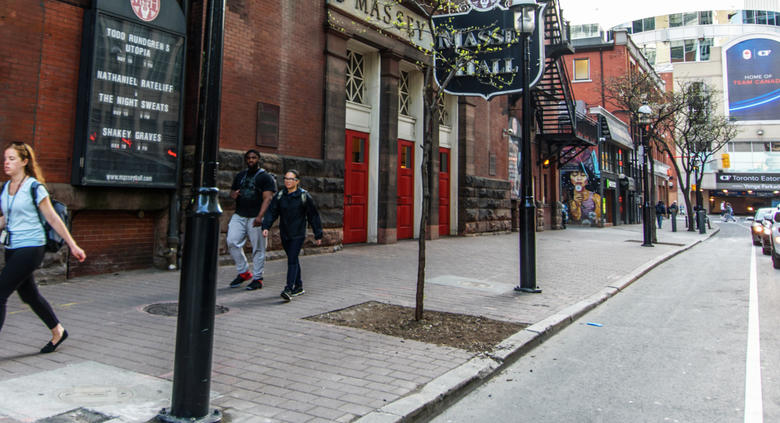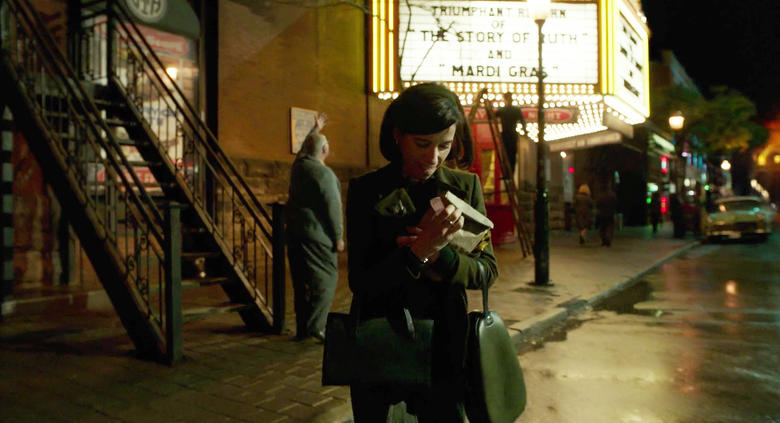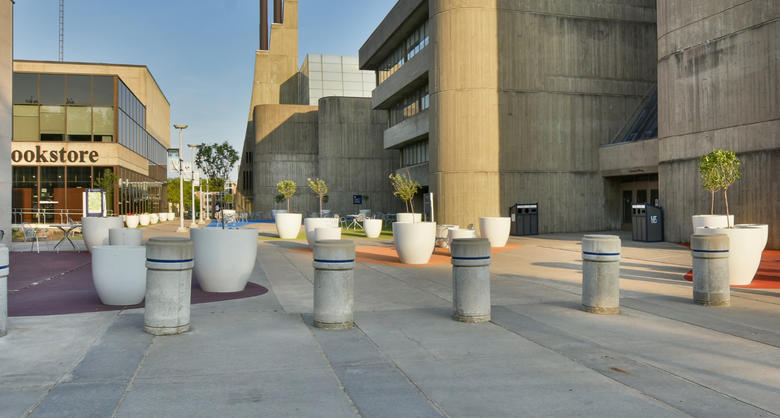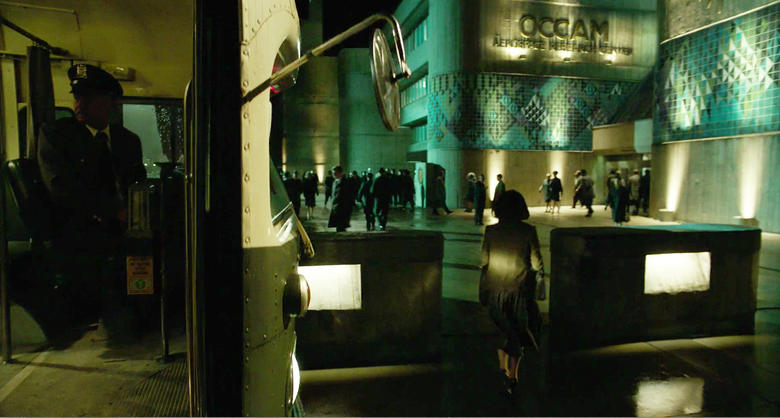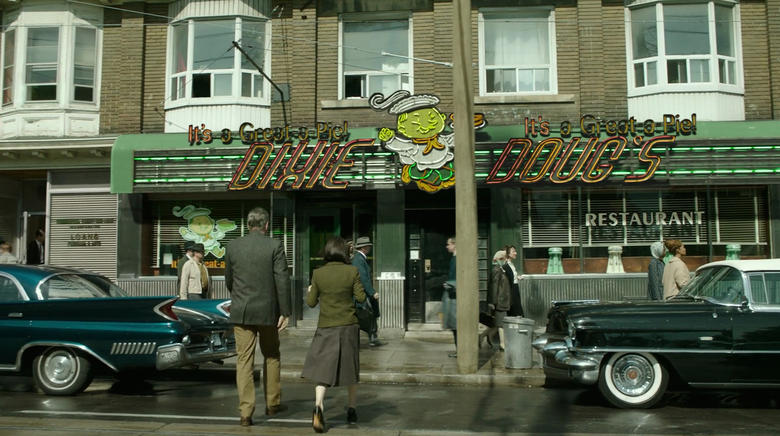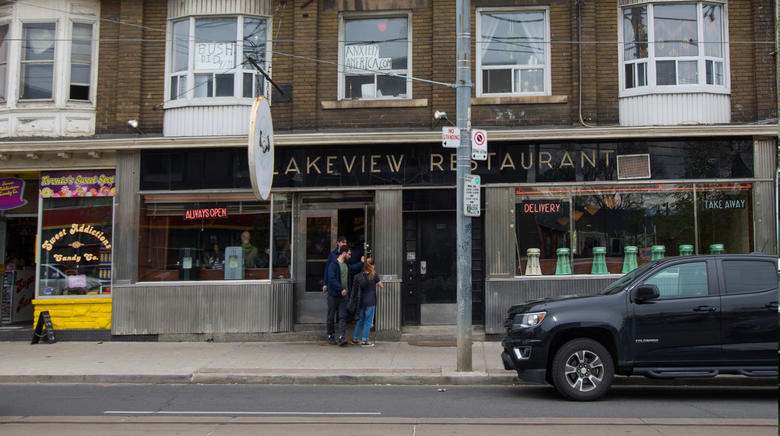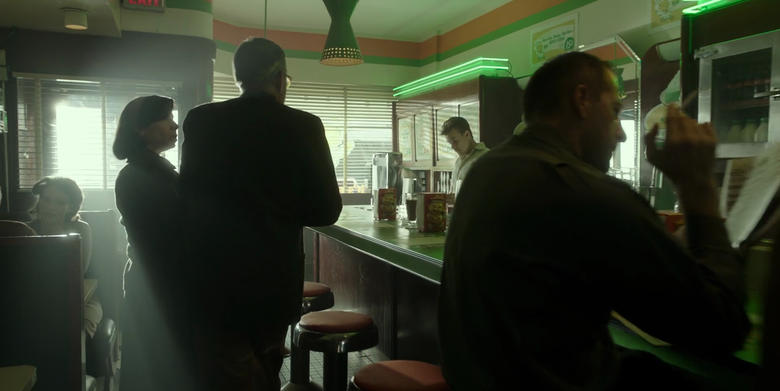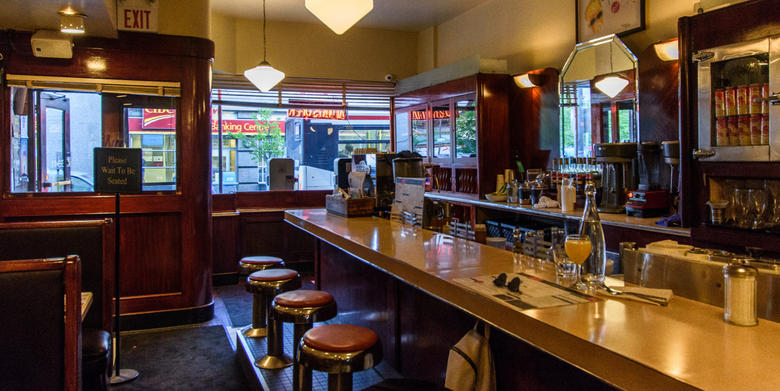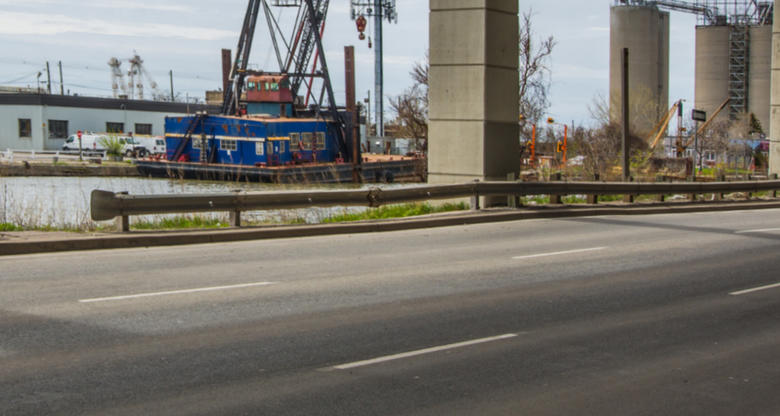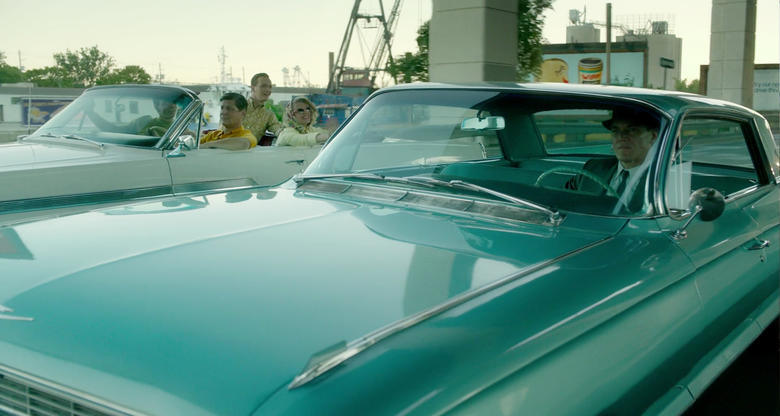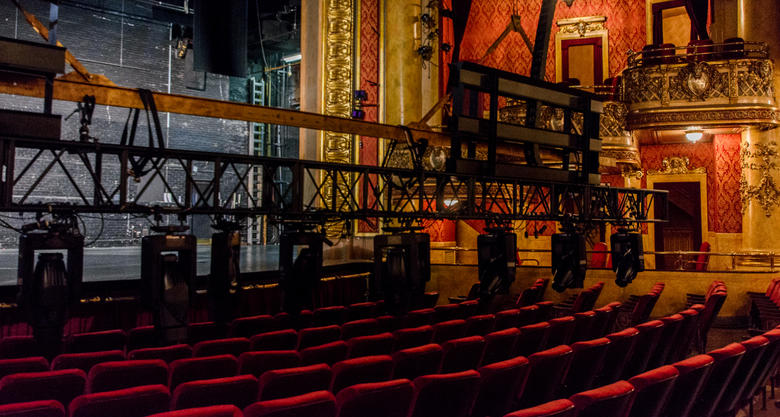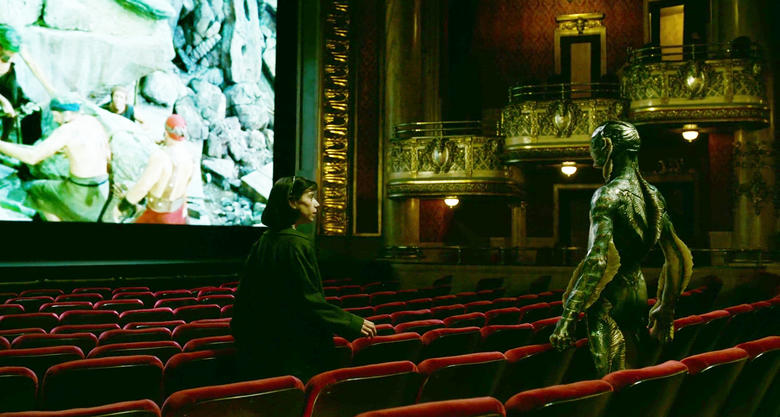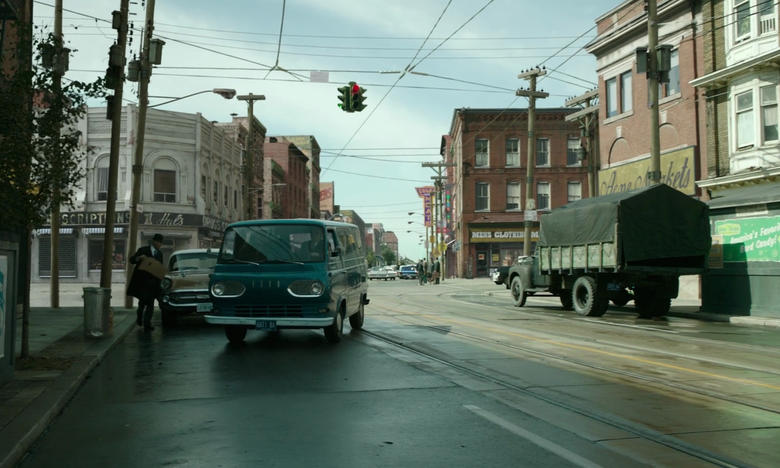Masquerading as mid-century Baltimore, Guillmero Del Toro's The Shape of Water (2017) brings back a distinctly retro feeling to Toronto, and some Oscar buzz with it. Filmed entirely in southern Ontario and with a crew almost entirely made up of Canadians, most film-loving Torontonians were thrilled at the shout out to our city from the three-man design team as they accepted the Academy Award for Best Production Design for their work on the incredibly popular and highly-lauded monster movie.
And there's a solid reason behind the Oscar win: so good are the set designs and CGI, that if you didn't know it going in, you may not have even realized The Shape of Water is even filmed in Toronto at all! At least not until you see the imposing pillars of the unmistakable Gardiner Expressway, that is. While most of the movie was filmed on sets in Cinespace Studios, there are a few locations that stand out to a trained eye and most of them are introduced in the first 10 minutes!
↑ Move slider to see the difference!
The first transformation is the historical performing arts landmark that many of us are familiar with in one way or another: Massey Hall. Here, the exterior doubles as the front of the movie cinema where the main character, Elisa, a mute orphan, lives. As with almost all interiors, her actual apartment is merely a set but the flashy marquee she passes on her way to work is right at the entrance for Massey Hall which is coming up on the 37th anniversary of its National Historic Site designation. It almost looks like we'd imagine it did back in the early 1960s.
Moments later, we're transported west across the city to the neighbourhood of Trinity-Bellwoods as Elisa waits for the public transit bus to take her to work at the top secret government laboratory, all the way to Scarborough at the University of Toronto's most easterly campus.
Drawing on the brutalist architectural style of the mid-60s ubiquitous across Toronto, the Andrews Building had not even been built when the film is set, but it certainly fits into the tone of the movie seamlessly. And if you've even been inside this massive monolith of concrete, you'd notice how the lab sets del Toro built for the film fit perfectly with UTSC's interior design.
Elisa's best friend in the film is her neighbour, a struggling ad illustrator and a somewhat reclusive gay man named Giles who understands sign language. They share the upstairs units of the cinema venue and often spend time together, including a trip back to Dundas and Ossington to try the disgusting key lime pie at Dixie Doug's diner, for Giles to clandestinely enjoy the company of the server. The restaurant they tapped for this diner's double couldn't have been better. The Lakeview Restaurant has defiantly retained its vintage decor and atmosphere for decades despite the trendy push of the neighbourhood. It's one of the few interiors that is shot on location. Sadly it's also the site of heartbreak for Giles and a cold dumping of water to remind people of the time period in all its prejudices and bigotry.
Outside, we can see a feat of computer brilliance that warps the modern intersection into a living, breathing version of what it could have looked like in the 60s. Gone is the CIBC, TD, and the West Neighbourhood House replaced instead with period-authentic CGI. But at least they left in the building with The Grow Op. Where else are these characters going to get vegan hemp milk smoothies?
The clear villain of the movie is a terribly unsympathetic army researcher, Strickland, who literally would rather cut his aquatic discovery into pieces than understand it as a living creature at all. In a strange attempt to give the 1-dimensional character something resembling a story, we are given a glimpse at his normal home life and him buying the newest, most flashy Cadillac status symbol and speeding it down - yep, you guessed it! - The Lakeshore right along the Keating Channel, which is also the location of the iconic shots of the Amphibian Man and Elisa's escape.
The driving force of the film is otherness, connection, and the love story that builds rather quickly between Elisa and the captured fishman. All the main characters, aside from the villain, are isolated by their otherness in relation to the wider society. Elisa, as a mute who requires sign language, is literally incapable of communication with anybody except those who have learnt her way of speaking. Giles lives his life in the closet because of his sexuality and his professional life suffers as well. Zelda, Elisa's caring coworker and translator, is a Black working-class woman in 1962 America. Even the Soviet spy, Dr Hoffstetler, is isolated due to not only his dangerous politics but his empathy for the "asset" as the Amphibian Man is known to the researchers. Clearly, the most strange of all the characters is the creature from a South American riverbed, kidnapped and tortured for the sake of science, or more specifically, for the sake of building a biological weapon to use against the Soviets in the Cold War.
All of these characters come together in a daring plan to rescue the fishy oddity from the facility with the end goal of eventually setting him free into the ocean. Giles and Elisa arrange transport and alter security cameras while Dr Hoffstetler disables the electrical grid, neutralizes a guard, and provides additives for the fishman to survive in fresh water, and Zelda not only covers for Elisa but assists her in moving the hidden Amphibian Man into the van as well as helping cover up the escape afterwards.
After a few days of freedom, Giles falls asleep during his watch of Amphibian Man in Elisa's bathtub, and he escapes. A frenzied search begins and eventually, Elisa follows a trail of blood to another unmistakable Toronto landmark: The opulent, impressive Elgin Theatre. Part of the complex that houses The Winter Garden Theatre as well, this performing arts centre has an incredible history that every Torontonian should know as they are the last surviving stacked Edwardian theatres in the world.
The history of the Elgin and Winter Garden theatres stretch all the way back to 1913 when they were originally built for vaudeville shows and hosted all of the greats. By the 1930s, as vaudeville left favour and the money drained out, the beautiful Winter Garden was sealed up completely and the Elgin began showing movies. At its lowest point in the 1970s, the Elgin began what was expected to be its swan song - as a pornographic film venue. In the late 1980s, it was rescued, restored, and given new life for not only movies but live theatre again. A year following Massey Hall's designation as a National Historic Site, The Elgin and Winter Garden received theirs.
It is inside this restored Elgin Theatre where Elisa finds her amphibious lover staring in awe at the film emblazoned across the screen in an empty cinema. It is also in this theatre where The Shape of Water had its premiere at the Toronto International Film Festival, much to the delight of the predominantly Canadian audience. And lucky for us, there was no manufactured soundstage set used to replicate this; it's the real deal.
Despite all the CGI, special effects, and fishman, there is a sense of realism present in the way the characters relate to each other. The tone remained consistent, and the thread of loneliness and alienation wove itself nicely throughout. And, boy, does del Toro seem to love green! The entire palette of the cinematography is glazed with a green tone and the small details such as Strickland's candy, Dixie Doug's key lime pie, the "green or teal" Cadillac, or Giles' Jell-O advertisement use vibrant green colours. And that's not even talking about the biggest green feature: the Amphibian Man. But it's the colour blue that is important. Without giving too much away, the brief glimpse of glowing blue is what really speaks to the characters and their healing.
Without giving away the ending, I can reveal that if you hadn't known it was filmed in Toronto, you would know by the waterside scenes. The lumbering geometric pillars that hold up the Gardiner Expressway are obvious even with the CN Tower digitally removed in post-production. While the location Elisa stands on is the fenced-off property of the Toronto Port Authority, the Keating Channel is clear as day even as the magic of computers drained it.
Probably the small aspect I enjoyed most about the film was the insinuation that Amphibian Man is not merely a evolutionary leftover from a subtropical lagoon but, in fact, a god. The idea that we may never recognize a god even when face to face with one, simply because they are different from us and to many people can appear lesser than humans, I think can speak on an even more basic level. We never can know the depth of a person, or any living thing, simply from outside appearance alone. Inside what we may consider the most grotesque, confusing or inhuman exterior could be the soul of a god, or at least, feeling and love.
In each of their ways, the characters represent this concept as well. When judged for a single trait alone, whether it's disability, race, or sexuality, we can never even attempt to comprehend the entirety of another human being. Even politics alone is not always indicative of who somebody truly is. We have no idea what a person is capable of, what they know or feel, their capacity for love and empathy, only based on superficial traits alone. Additionally, there is a real connection in the inclusive bonds formed with people different from you.

The film itself leaves a little to be desired and can easily be seen as yet another riff on the "Beauty and the Beast" motif. It follows basically the same trajectory, with no big surprises. It's not a movie that breaks any significant moulds, makes any particular strong statements, or even is that creative a take on an age-old fairytale trope. It's a simple story about falling in love with what society deems a monster, and the types of real emotional bonds that are made between those of us who are different, not just as lovers but also as friends. We've all seen and heard it before but that doesn't make it any less of a beautiful film, even if its just aesthetically.
While the special effects, costumes, and set design were all worthy of awards, the true strength of The Shape of Water is in this very simple and obvious message of the beauty of love without prejudice.
VLVLKS




